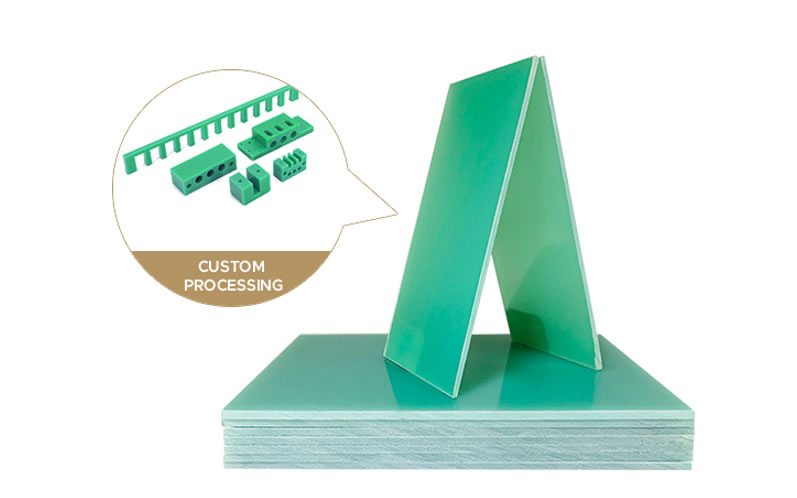1.Heat Resistance Rating of FR4 (Accurate Version) FR4 epoxy sheet is a composite material made from epoxy resin and...
FR4 epoxy sheet is a composite material made from epoxy resin and woven fiberglass cloth. Its thermal capability mainly depends on the resin system, Tg, and curing process.

| Type of FR4 | Continuous Operating Temperature | Thermal Class | Notes |
|---|---|---|---|
| Standard FR4 | 110–130°C | Class B (130°C) | Used in general-purpose PCBs and electrical insulation parts |
| Enhanced / Modified FR4 | 130–150°C | Close to Class F (155°C) | Used for electrical insulation structural parts |
| High Tg FR4 (Tg150 / Tg170) | ≈150°C (not exceeding 160°C) | Not an H-class material | High Tg ≠ high continuous operating temperature |
Tg (glass transition temperature) indicates the temperature at which the resin starts to soften
It is not the allowable long-term operating temperature
Even high-Tg FR4 typically supports only ≤150°C continuous usage
To help engineers make decisions quickly, below is a comparison between FR4 and other common insulation laminates:
| Material | Continuous Temperature | Thermal Class | Characteristics |
|---|---|---|---|
| FR4 | 130–150°C | B ~ F | Low cost, good machinability, widely used |
| G10 | 130°C | B | Good mechanical strength, moderate heat resistance |
| EPGC203 | 155°C | F | Widely used in electrical and power equipment |
| G11 | 180°C | H | High temperature & high reliability applications |
| EPGC204 | 180–200°C | H | Premium high-temperature laminate |
Below is a practical decision-making process used by engineers.
| Application Temperature | FR4 Applicable? | Recommended Material |
|---|---|---|
| ≤120°C | ✔ Fully suitable | Standard FR4 |
| 120–140°C | ✔ Use enhanced FR4 | Modified FR4 |
| 140–155°C | ⚠ Borderline, near performance limit | EPGC203 recommended |
| 155–180°C | ✘ Not suitable | G11 |
| ≥180°C | ✘ Forbidden | H-class or PI-based insulation |
| Voltage Level | FR4 Suitability | Notes |
|---|---|---|
| Low voltage ≤1kV | ✔ Very suitable | PCB, low-voltage insulation |
| Medium voltage 3–12kV | ✔ With high-quality FR4 | Use ≥3–5mm thickness |
| 24–40kV | ⚠ Not recommended | Use EPGC203 or G11 |
| ≥66kV | ✘ Not suitable | Requires high-voltage pressboard/laminate |
FR4 has moderate mechanical strength. For heavy-load applications, it is not recommended.
| Load Level | FR4 Suitable? |
|---|---|
| Light load (electronic parts, PCB) | ✔ |
| Medium load (general support pieces) | ✔ with thicker FR4 |
| Heavy load (transformer clamping plates, structural supports) | ✘ Use EPGC203 / G11 |
| Application | Recommended Material | Reason |
|---|---|---|
| PCB, control boards | FR4 | Standard application |
| Low-voltage insulation | FR4 | Adequate thermal capability |
| Switchgear partition (medium voltage) | Thick FR4 / EPGC203 | Depends on voltage level |
| Transformer clamping parts | ❌ Not FR4 | Insufficient strength & heat resistance |
| Inverters, power modules | High Tg FR4 | Suitable if temperature rise is controlled |
| Energy storage systems, PV | EPGC203 | Higher safety requirement |
| High-temperature motors, transformers | G11 / EPGC204 | H-class needed |
FR4’s reliable heat resistance: 130–150°C.
Do NOT use FR4 for >150°C, high-voltage, or heavy-load environments.
For improved reliability → EPGC203 (155°C)
For high-temperature 160–180°C → G11 (180°C)

Xujue Eeletrical is a professional manufacturer of high-quality electrical insulation materials with more than 65 years of manufacturing experience. If you need more product information and quotes, please contact us.
If you are interested in our products,, please send us a message and we will contact you as soon as we receive it. Email: info@ztaero.com whatsApp: +8616650273778